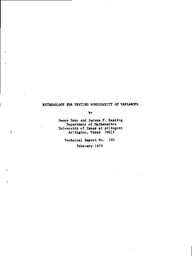
ATTENTION: The works hosted here are being migrated to a new repository that will consolidate resources, improve discoverability, and better show UTA's research impact on the global community. We will update authors as the migration progresses. Please see MavMatrix for more information.
Show simple item record
| dc.contributor.author | Dyer, Danny D. | en |
| dc.contributor.author | Keating, Jerome P. | en |
| dc.date.accessioned | 2010-06-01T19:14:49Z | en |
| dc.date.available | 2010-06-01T19:14:49Z | en |
| dc.date.issued | 1979-02 | en |
| dc.identifier.uri | http://hdl.handle.net/10106/2219 | en |
| dc.description.abstract | **Please note that the full text is embargoed** ABSTRACT: Suppose random samples are drawn from each of n populations with unknown means and variances. Developing procedures to test the claim that the population variances are equal (homogeneity of variances) has frequently been a goal for statisticians. One widely used technique is due to Bartlett (1937) and is based on a slight modification of the generalized Neyman-Pearson likelihood ratio test. It is well known, however, that Bartlett's test is highly sensitive to the assumption that the underlying populations are normal (Box, 1953). If nonnormality is present, the use of Bartlett's test can often lead to the rejection of the claim of equal variances far more often than prescribed by its nominal level of significance. In other words, in this situation Bartlett's test is very conservative. In an attempt to circumvent this problem, several "robust" (relatively insensitive to nonnormality) tests for homogeneity of variances have been developed. The price paid for the robustness is less power than Bartlett's test when the populations are, in fact, normal. Consequently, it would seem appropriate to precede the possible use of Bartlett's test with a test for normality of the populations. If after such a test one concludes the normality assumption is not unreasonable, then Bartlett's test could follow. Otherwise, a robust test should probably be used. There are, at present, several tests for normality; however, the one in vogue is the Shapiro-Wilk (1965) test. This test, like its competitors, is designed to detect nonnormality in a variety of distributions and for moderate to large sample sizes. For sample sizes less than 10, there does not appear to be any reasonably powerful test for normality. As a matter of fact, when sample sizes are small, the power of the robust tests for homogeneity of variances is suspect. | en |
| dc.language.iso | en_US | en |
| dc.publisher | University of Texas at Arlington | en |
| dc.relation.ispartofseries | Technical Report;103 | en |
| dc.subject | Homogeneity of variances | en |
| dc.subject | Nonnormality | en |
| dc.subject | Normality | en |
| dc.subject.lcsh | Statistics | en |
| dc.subject.lcsh | Mathematics Research | en |
| dc.title | Methodology for Testing Homogeneity of Variances | en |
| dc.type | Technical Report | en |
| dc.publisher.department | Department of Mathematics | en |
Files in this item
- Name:
- MathTechReport103.pdf
- Size:
- 2.985Mb
- Format:
- PDF
- Description:
- PDF
This item appears in the following Collection(s)
Show simple item record


